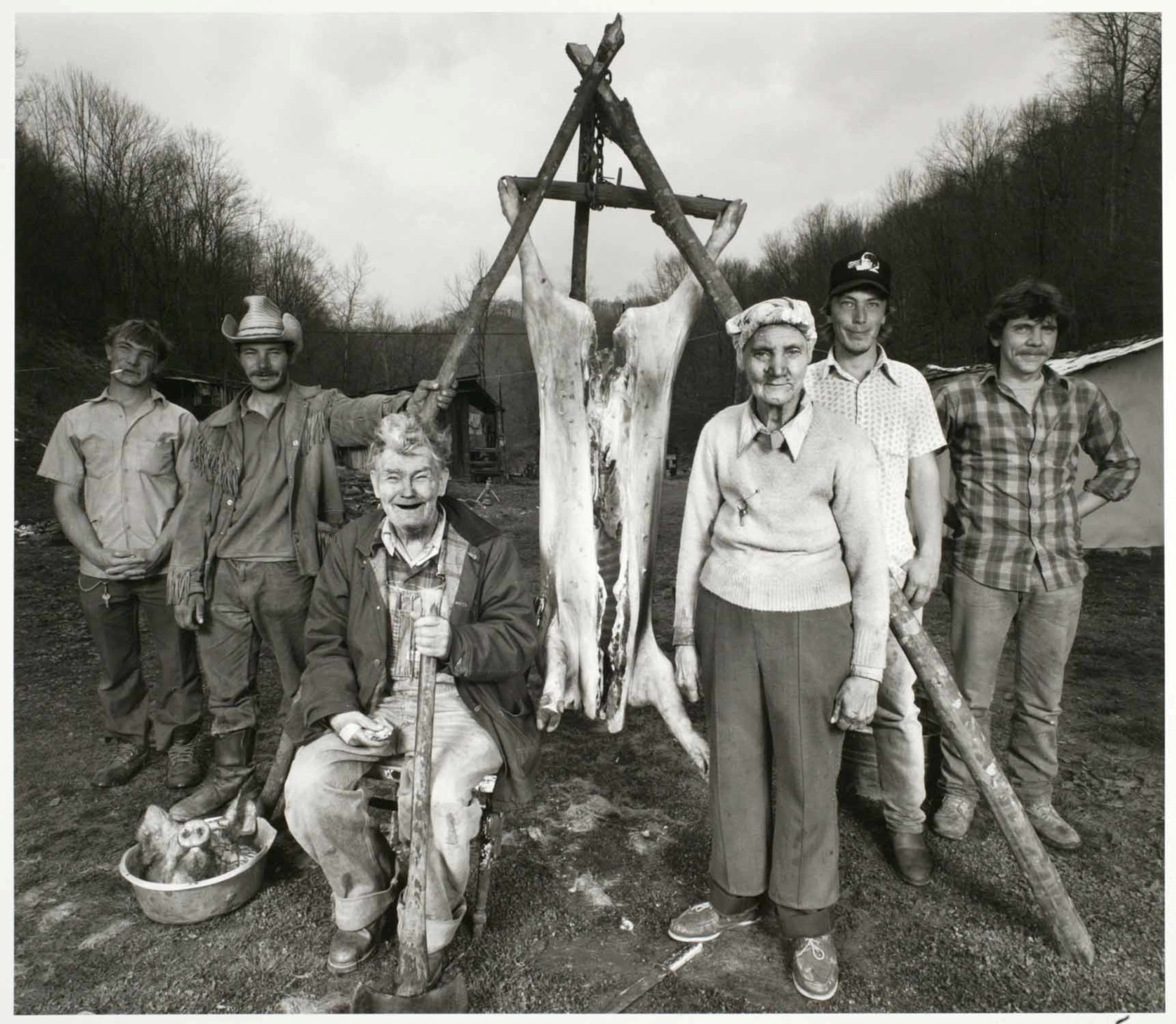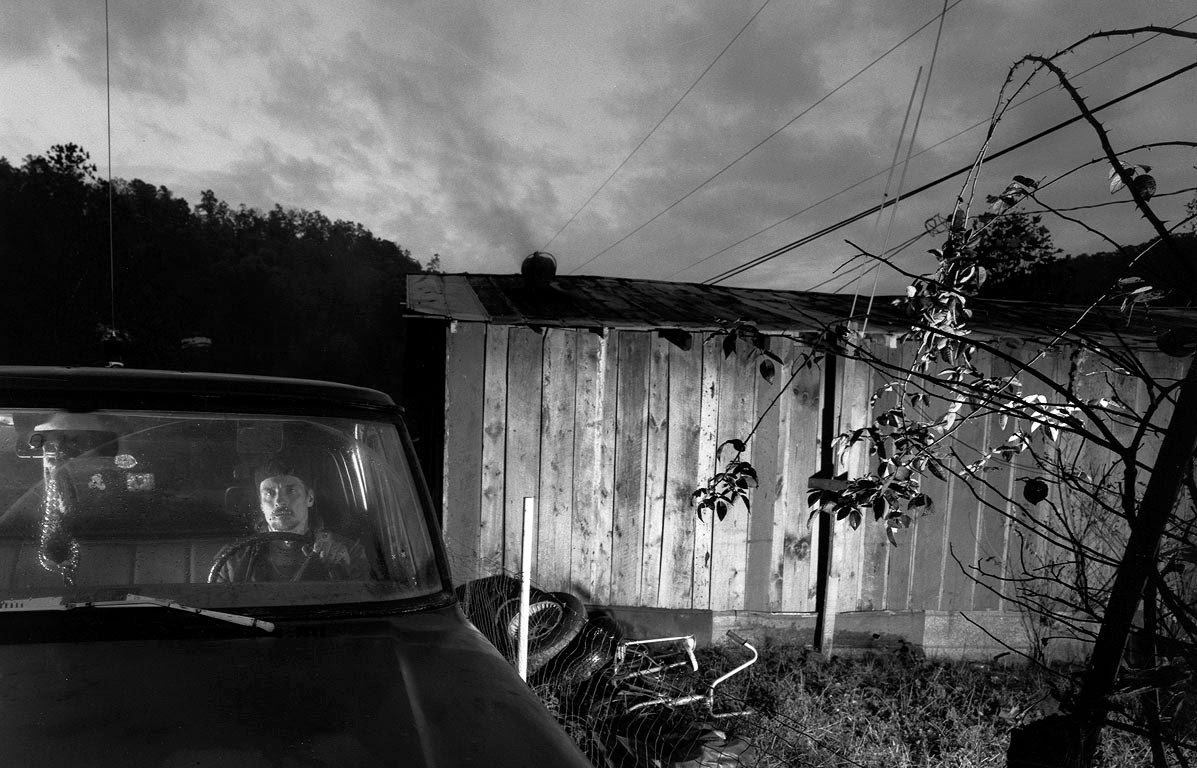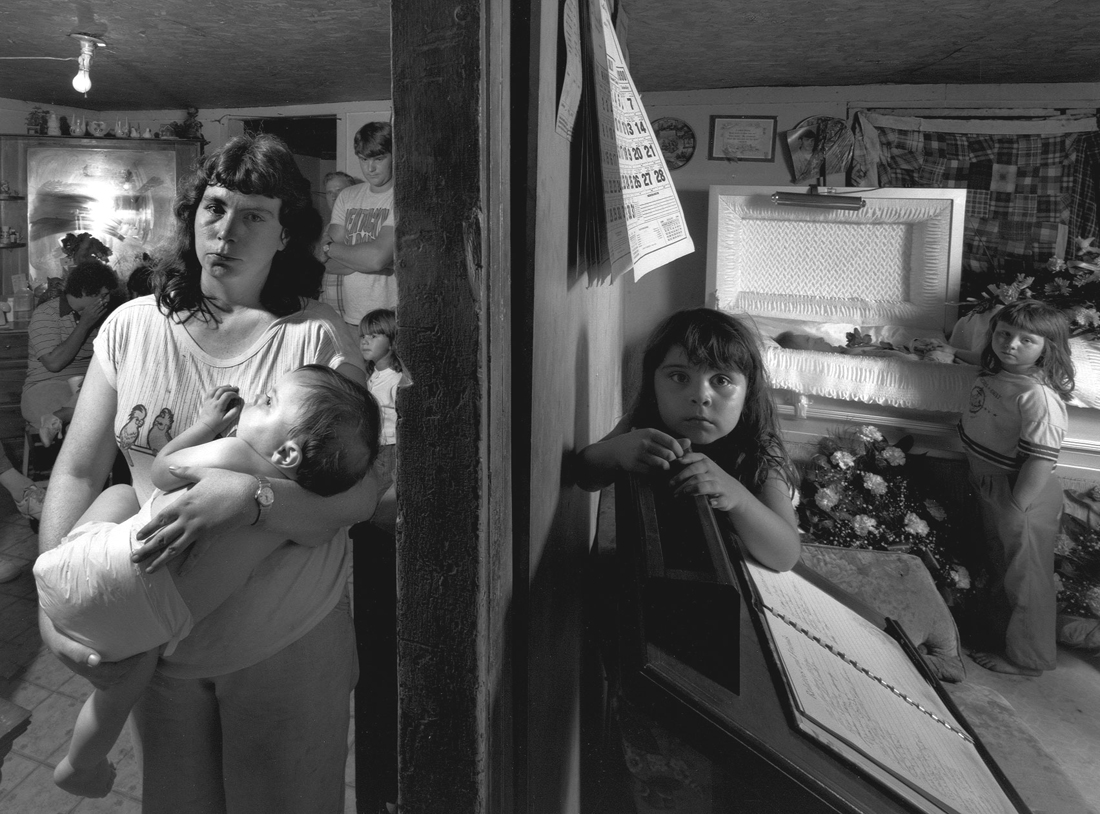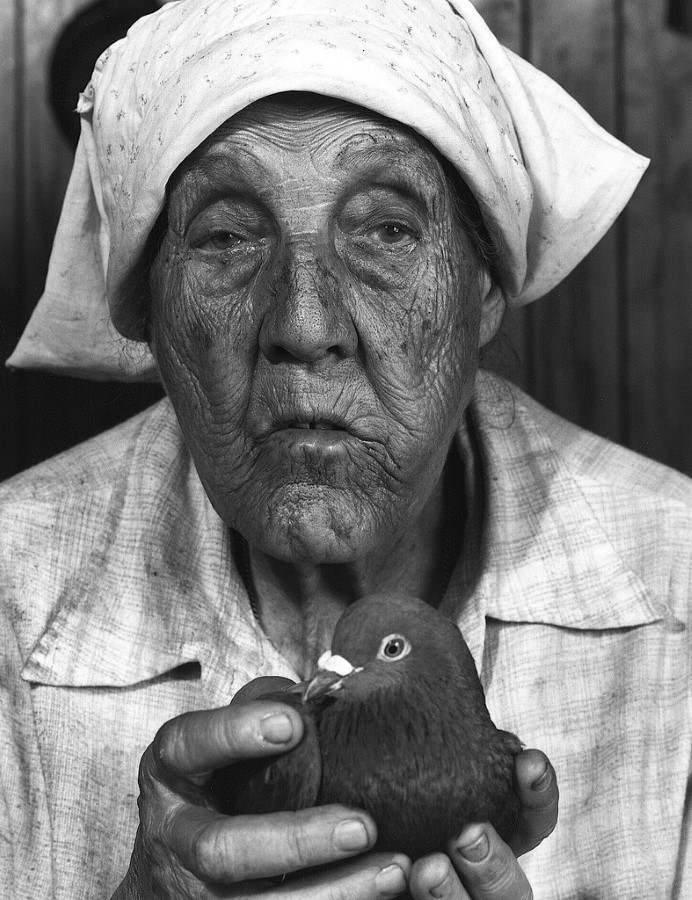Getting out of the truck, this place felt like being taken back in time.
By Shelby Lee Adams, 2007
In the early ’80’s I was taken to visit the Napier family by a local preacher and friend Wayne Riddle from Leatherwood. I was advised not to drive my car, as the roads were rough. We loaded my equipment into the back of my friend’s pickup truck and drove into the head of the holler called Beehive. Leaving the main road we’re driving up a single lane dirt road that went through the creek three times with deep washed out gullies. Underbrush and tree limbs scrapped the sides of Wayne’s truck as we drove. Suddenly, we were in an open valley populated with several small houses, smoke ambling out of the chimneys, chickens everywhere, a white mule in a barnyard and hound dogs came running and barking, their barks echoing through the valley before disappearing.
Getting out of the truck, this place felt like being taken back in time. Electric was minimally wired from a black 1/2 inch rubber coated cord that was propped up by wood planks with crooked nails on end. The well was hand dug, with a wooden box over it; a hemp rope and metal pulley were attached to draw crystal clear buckets of water. Each house appeared pieced together with wood scraps; cardboard and rusty tin roofing materials. The smoke smelled of fresh pinewood and cedar. This seemingly time warped community was more like visiting an early American pioneer life reenactment village, but it was not.
Meeting John and Berthie Napier was easy, they were friendly, John’s laugh was fastidious and Berthie smiling, shy, pipe in mouth, head rag on, they were openly glad to have company. When my friend Wayne introduced me as a photographer, John told me about a photographer he remembered, who used to travel by horseback. When John saw my view camera and tripod he nodded, and said, “same thing”. Berthie swept the dirt yard with a broom intermittently, shooing the chickens and diddles away, it seemed as a habit of housework. The Napier’s sons wandered over to their parents home, one at a time, from their homes, and said hello, shook hands, stood around and talked.

Joe at Mother’s Funeral, ’98
Their world was of the pure old Appalachian spirit, I had only witnessed this as a child.
When leaving after my first visit, my head was spinning. I had never met a family that lived in such a manner. Their world was of the pure old Appalachian spirit, I had only witnessed this as a child. They had somehow survived without adapting to modern ways. That summer, I had a few more visits but always relying on someone taking me by truck. I was in my mid thirties then and felt this family was one of the most important I’d met. I went back to Massachusetts and began researching four-wheel drive vehicles and by the summer of ’88 I had purchased a new Nissan Pathfinder, if for no other reason than to visit the Napier’s.
This family represented the true primitive spirit from which many mountain people came. They had not been photographed by the media or affected by modern ways, and they were open. Representing authentically the old mountain culture, I remembered from childhood. If any flaw existed it was the incongruity in time of the making of these photographs. Their life style appeared to be from a century ago, except for small details like the logos on caps reading “Camel Joe” or “Michael Jackson”. My knowledge of the history of photography, the FSA period, the War On Poverty, childhood experiences and knowing Appalachian stereotypes would inform this work and hopefully help move it forward.

One of the first Napier environments that interested me had a complex history, both personal and historically. The use of newsprint and cardboard as wallpaper on the inside of modest homes became iconic in the photographic work of Lewis Hines, long before the FSA depression era photographs were made. Later Walker Evans, Margaret Brooke White, Russell Lee and writers for example James Agee; all used this background to inform their work. Evans was the first to see and use this material in an aesthetic manner. This material influenced the sixties Andy Warhol generation and more contemporary work today for example, Zwelethu Mthethwa. Here it was in the Napier’s living room in 1989. I had never personally seen this newspaper background in any home, in my adult life. Remembering as a child in the late ’50’s when I was in 2nd grade through 6th grade, I visited many homes with my mother while she was distributing annually my used school clothes to needy families in our community. Many country homes in the hollers of the ’50’s had this type of interior. We didn’t think anything of it, it was a way of keeping the cold wind and weather out. No one could afford insulation or better building materials. Country stores gave away advertising posters and newspapers, we saw it as shelter. For some mountain people, this to just became a tradition. Every spring you redid the walls and ceilings with fresh newspaper.
Part of the school year, I attended the Hot Spot Elementary School in the mountains and the rest of the school year I traveled with my father, attending school where ever his work took us. Some of my Kentucky classmates wore my older clothes to school. They let me know that they resented it, which I did not understand as a child. In my high school years, the newspaper background environment resurfaced, charged with new media underhanded covert activity. The ’60’s and early ’70’s was the time of the War on Poverty, the Vista workers and Peace Corps all came to Appalachia. When in art school at age 21 upon my first viewing the FSA photography, I strongly disliked it; it took some time for me to come to terms with this work.
The FSA work had also impressed the world, so much so, that the outside media of the ’60’s and ’70’s, during the War on Poverty era came to Appalachia as photographers, journalist and film makers in search of the same. If the newspaper backgrounds could not be found, and they often could not, things were improving, compromised families were paid to paste and glue newsprint to their kitchen walls and homes for photographs and films to be made. This was the environment I grew up in and local people spoke up, they felt shamed. Folks said, “They come in here to help us, by makin’ us look worse than we are, we don’t like it”. I grew up within a whirlwind of local gossip, rumors, stories and national media distortions. All for the benefit of the people.

The Napier Family, ’89
Photographing “The Napier’s Living Room”, 1989 was done to make “amens” somehow, to put to rest some personal dissatification and to contribute to this outsider/insider historical litany of images.
In the summer of ’89, I spoke with Berthie about photographing in her living room with the newsprint walls. To my surprise, she spoke proudly of them. Berthie told me, she learned “paperin” from her mother. She talked about the mixture of wheat paste and boiled water used in making the glue, how long it took for it to dry, etc. I made a Sunday 10:30 AM morning appointment with her and John to come and photograph in her living room, with whom ever wanted to be in the picture. I arrived that morning, Berthie greeted me on the porch, her hands were dirty, with dried paste and her forehead was sweaty. She said, “Now, I want you to know I’ve got a brand new living room; stayed up till 2:00 this mornin’ repapering everything.” I felt my heart sink to the floor, thinking she had taken out the newsprint and painted over everything. Entering the living room, she said, “I got to studyin’, I didn’t want you to come take pictures with my smoked up ceilings black from the winter coal fires, so I got the boys to help me repaper everything last night. It looks better clean don’t you think?” “Sure doe’s,” I said, as I looked with relief. Dan and James, two son’s came over with Tricky, a pet dog. I set up my camera and lights and we began making Polaroid’s, we were exposing film by noon.
In the summer of ’89, I spoke with Berthie about photographing in her living room with the newsprint walls. To my surprise, she spoke proudly of them. Berthie told me, she learned “paperin” from her mother. She talked about the mixture of wheat paste and boiled water used in making the glue, how long it took for it to dry, etc. I made a Sunday 10:30 AM morning appointment with her and John to come and photograph in her living room, with whom ever wanted to be in the picture. I arrived that morning, Berthie greeted me on the porch, her hands were dirty, with dried paste and her forehead was sweaty. She said, “Now, I want you to know I’ve got a brand new living room; stayed up till 2:00 this mornin’ repapering everything.” I felt my heart sink to the floor, thinking she had taken out the newsprint and painted over everything. Entering the living room, she said, “I got to studyin’, I didn’t want you to come take pictures with my smoked up ceilings black from the winter coal fires, so I got the boys to help me repaper everything last night. It looks better clean don’t you think?” “Sure doe’s,” I said, as I looked with relief. Dan and James, two son’s came over with Tricky, a pet dog. I set up my camera and lights and we began making Polaroid’s, we were exposing film by noon.
Photographing “The Napier’s Living Room”, 1989 was done to make “amens” somehow, to put to rest some personal dissatification and to contribute to this outsider/insider historical litany of images. For an artist, clarity is made into physical forms, in this case a photograph between conscious reality and unconscious feelings, hurts and needs. This photograph speaks with my interpretation to the meaning of authenticity; it is made with the subject’s awareness, cooperation and enthusiasm. That is important to all my portrait photographs. Further, this photographer has no specific assigned agenda, but many memories and thoughts of how it might have been done before, right or wrong. This is the problem where we all get caught; we view photographs and make them with our agendas, personal histories, stereotypes and biases. This subject has a history and it is a thorny one. It is my intention to make photographs like “The Napier’s Living Room” with an open mind and open heart. Hopefully the viewer might see something here “a new” without preconceived ideas or bias, that too requires an open mind from the viewer.
What comes from the depths of one’s efforts ? Does time, memory, long term relationships and multiple portrait sessions create more validity ? Do we see with different eyes ? Is this longevity multiplying perspectives and does this take us forward ?
For more of American Suburb X, become a fan on Facebook and follow ASX on Twitter.
For inquiries, please contact American Suburb X at: info@americansuburbx.com.
(© Shelby Lee Adams, 2009. All rights reserved. All images © copyright the photographer and/or publisher)




